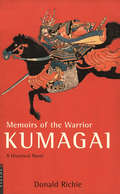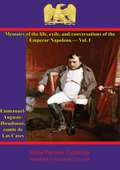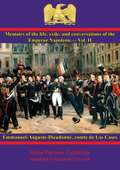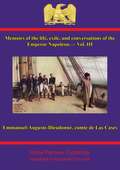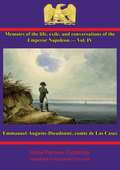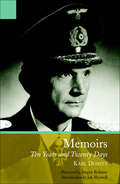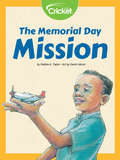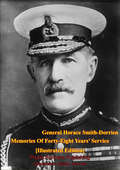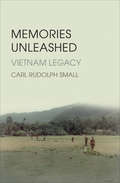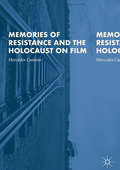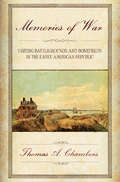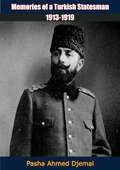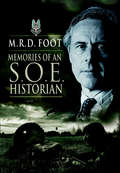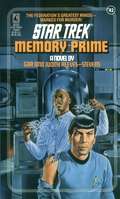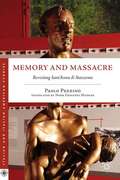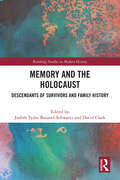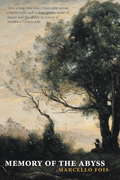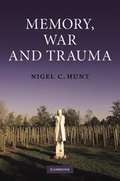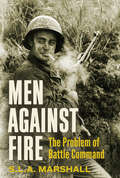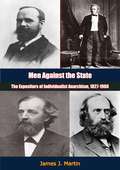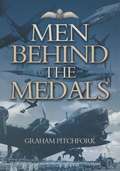- Table View
- List View
Memoirs of the Warrior Kumagai
by Donald Richie"A tour de force combining a commanding mastery of historical fact and detail, a comprehensive understanding of the human spirit, and a poetic quality of expression that transforms the hearts of all those it touches." -The Japan Foundation NewsletterKumagai Naozane was a Japanese warrior famous for having taken the head of the young and handsome samurai Atsumori. This episode has become one of the best-known and best-loved stories in the Japanese historical classic, The Heiké Story (Heike Monogatari). This book is a fictionalized version of Kumagai's own attempt to come to terms with his past-that real past which is his and that other past which he hears the monks inventing as they compose the text which will eventually become The Heiké Story.As the warrior remembers his past and compares it to its fictional parallel, he evokes the wonders of the city of Heiankyo (Kyoto); the wars which raised the Taira (Heike) clan to power and later reduced it to ruin at the hands of the Genji clan; the battles at the Uji River; life in the imperial court of the retired emperor Go-Shirakawa; and the celebrated final Taira battle-the naval encounter at Dannoura, where the infant emperor Antoku was delivered to the depths of the sea. Among the many pleasures of this brilliantly colored chronicle is how the common humanity of this honest, hopeless man transcends his time and milieu to speak to us, here and now.
Memoirs of the Warrior Kumagai
by Donald Richie"A tour de force combining a commanding mastery of historical fact and detail, a comprehensive understanding of the human spirit, and a poetic quality of expression that transforms the hearts of all those it touches." -The Japan Foundation NewsletterKumagai Naozane was a Japanese warrior famous for having taken the head of the young and handsome samurai Atsumori. This episode has become one of the best-known and best-loved stories in the Japanese historical classic, The Heiké Story (Heike Monogatari). This book is a fictionalized version of Kumagai's own attempt to come to terms with his past-that real past which is his and that other past which he hears the monks inventing as they compose the text which will eventually become The Heiké Story.As the warrior remembers his past and compares it to its fictional parallel, he evokes the wonders of the city of Heiankyo (Kyoto); the wars which raised the Taira (Heike) clan to power and later reduced it to ruin at the hands of the Genji clan; the battles at the Uji River; life in the imperial court of the retired emperor Go-Shirakawa; and the celebrated final Taira battle-the naval encounter at Dannoura, where the infant emperor Antoku was delivered to the depths of the sea. Among the many pleasures of this brilliantly colored chronicle is how the common humanity of this honest, hopeless man transcends his time and milieu to speak to us, here and now.
Memoirs of the life, exile, and conversations of the Emperor Napoleon, by the Count de Las Cases - Vol. I (Memoirs of the life, exile, and conversations of the Emperor Napoleon, by the Count de Las Cases #1)
by Comte Emmanuel-Auguste-Dieudonné de Las CasesBefore the shattering of the Napoleonic empire in 1815, Count Las Cases had served loyally for many years in the council of state. However, his most important service was to come after he followed his Emperor into exile on St. Helena. During his time with Napoleon on the "Rock in the Atlantic", he was to write down all that he heard from the Emperor's mouth, as clear a stream of his thoughts and reminiscences as were ever recorded. He was to eventually publish these entries as the "Memoirs of the life...", also known as the Mémorial de St. Hélène. They stand as a classic not just of the history of Napoleon's times, but also of the history of the first year of his banishment.Ranging from his earliest days in Corsica to the ranging battlefields of his career, Napoleon speaks through these pages as in no other of the sources left to us today. Essential reading and the birth of the Napoleonic legend. Author -- Las Cases, Emmanuel-Auguste-Dieudonné, comte de, 1766-1842.Text taken, whole and complete, from the edition published in 1855, New York, by Red Field.Original Page Count - 400 pages.Illustrations -- 4.
Memoirs of the life, exile, and conversations of the Emperor Napoleon, by the Count de Las Cases - Vol. II (Memoirs of the life, exile, and conversations of the Emperor Napoleon, by the Count de Las Cases #2)
by Comte Emmanuel-Auguste-Dieudonné de Las CasesBefore the shattering of the Napoleonic empire in 1815, Count Las Cases had served loyally for many years in the council of state. However, his most important service was to come after he followed his Emperor into exile on St. Helena. During his time with Napoleon on the "Rock in the Atlantic", he was to write down all that he heard from the Emperor's mouth, as clear a stream of his thoughts and reminiscences as were ever recorded. He was to eventually publish these entries as the "Memoirs of the life...", also known as the Mémorial de St. Hélène. They stand as a classic not just of the history of Napoleon's times, but also of the history of the first year of his banishment.Ranging from his earliest days in Corsica to the ranging battlefields of his career, Napoleon speaks through these pages as in no other of the sources left to us today. Essential reading and the birth of the Napoleonic legend.Author -- Las Cases, Emmanuel-Auguste-Dieudonné, comte de, 1766-1842.Text taken, whole and complete, from the edition published in 1855, New York, by Red Field.Original Page Count - 400 pages.Illustrations -- 4.
Memoirs of the life, exile, and conversations of the Emperor Napoleon, by the Count de Las Cases - Vol. III (Memoirs of the life, exile, and conversations of the Emperor Napoleon, by the Count de Las Cases #3)
by Comte Emmanuel-Auguste-Dieudonné de Las CasesBefore the shattering of the Napoleonic empire in 1815, Count Las Cases had served loyally for many years in the council of state. However, his most important service was to come after he followed his Emperor into exile on St. Helena. During his time with Napoleon on the "Rock in the Atlantic", he was to write down all that he heard from the Emperor's mouth, as clear a stream of his thoughts and reminiscences as were ever recorded. He was to eventually publish these entries as the "Memoirs of the life...", also known as the Mémorial de St. Hélène. They stand as a classic not just of the history of Napoleon's times, but also of the history of the first year of his banishment.Ranging from his earliest days in Corsica to the ranging battlefields of his career, Napoleon speaks through these pages as in no other of the sources left to us today. Essential reading and the birth of the Napoleonic legend.Author -- Las Cases, Emmanuel-Auguste-Dieudonné, comte de, 1766-1842.Text taken, whole and complete, from the edition published in 1855, New York, by Red Field.Original Page Count - 400 pages.Illustrations -- 4.
Memoirs of the life, exile, and conversations of the Emperor Napoleon, by the Count de Las Cases - Vol. IV (Memoirs of the life, exile, and conversations of the Emperor Napoleon, by the Count de Las Cases #4)
by Comte Emmanuel-Auguste-Dieudonné de Las CasesBefore the shattering of the Napoleonic empire in 1815, Count Las Cases had served loyally for many years in the council of state. However, his most important service was to come after he followed his Emperor into exile on St. Helena. During his time with Napoleon on the "Rock in the Atlantic", he was to write down all that he heard from the Emperor's mouth, as clear a stream of his thoughts and reminiscences as were ever recorded. He was to eventually publish these entries as the "Memoirs of the life...", also known as the Mémorial de St. Hélène. They stand as a classic not just of the history of Napoleon's times, but also of the history of the first year of his banishment.Ranging from his earliest days in Corsica to the ranging battlefields of his career, Napoleon speaks through these pages as in no other of the sources left to us today. Essential reading and the birth of the Napoleonic legend.Author -- Las Cases, Emmanuel-Auguste-Dieudonné, comte de, 1766-1842.Text taken, whole and complete, from the edition published in 1855, New York, by Red Field.Original Page Count - 412 pages.Illustrations -- 4.
Memoirs: Ten Years and Twenty Days
by Karl Doenitz&“A fascinating and detailed account of the German navy&’s war, mostly covering U-boat activities&” by the man who succeeded Hitler as Fuhrer (Damien Burke, author of TSR2: Britain&’s Lost Bomber). This is the story of the last world war, as told by Grand Admiral Karl Döenitz himself. His memoir covers his early career with submarines in the First World War and follows both his successes and failures through the Second World War, with great detail on the way the U-boat campaign was waged, as told by the man who invented U-boat tactics. Döenitz includes details of the U-boat campaigns during the Second World War as well as the opinions, ideas and commentary on the period. Of particular interest are the comments regarding British and American conduct during the war. This is an important social document and an invaluable source for any student of the last war. After becoming the last Fuhrer of Germany after Hitler&’s suicide in May 1945, Karl Döenitz spent ten years and twenty days in Spandau Prison having been convicted of war crimes following a trial at Nuremberg. &“A very interesting book looking at the war in the Atlantic from the German side . . . one of the best accounts of the Battle of the Atlantic.&”—UK Historian
Memorial Day Mission
by Debbie TaylorBomber’s great grandfather was a Tuskegee Airmen during World War II. They were the first African Americans to ever become pilots! Bomber can’t wait for his “Poppy” to tell his class about being a pilot when an accident happens. Bomber now has to give the presentation! Will he get over his fear to tell the story of his great grandfather?
Memorial Mania: Public Feeling in America
by Erika DossIn the past few decades, thousands of new memorials to executed witches, victims of terrorism, and dead astronauts, along with those that pay tribute to civil rights, organ donors, and the end of Communism have dotted the American landscape. Equally ubiquitous, though until now less the subject of serious inquiry, are temporary memorials: spontaneous offerings of flowers and candles that materialize at sites of tragic and traumatic death. In Memorial Mania, Erika Doss argues that these memorials underscore our obsession with issues of memory and history, and the urgent desire to express—and claim—those issues in visibly public contexts. Doss shows how this desire to memorialize the past disposes itself to individual anniversaries and personal grievances, to stories of tragedy and trauma, and to the social and political agendas of diverse numbers of Americans. By offering a framework for understanding these sites, Doss engages the larger issues behind our culture of commemoration. Driven by heated struggles over identity and the politics of representation, Memorial Mania is a testament to the fevered pitch of public feelings in America today.
Memories Of Forty-Eight Years’ Service [Illustrated Edition]
by General Sir Horace Lockwood Smith-DorrienThe memoirs of a veteran general of the British army who fought through the heat of the South African kopjes and plains to the mud, rain and misery at Ypres. Illustrated with 11 photographs and 27 maps and plans. He fought in many of the Imperial wars in Africa, and was distinguished as one of only five British officers to escape the utter slaughter at the battle of Isandlwana in 1878 during the Zulu War.His enduring modern fame rests on his achievements during the First World War, when he was selected to command one of the two corps of the small British Expeditionary Force in 1914 by Lord Kitchener, firmly believing that Smith-Dorrien would stand up to the commander Sir John French. As the B.E.F. struggled back through Belgium in the face of German forces that greatly outnumbered their own troops in 1914, the strain on the men began to show; they thought that they had outfought the Germans at the battle of Mons, but physically they could not fight and outmarch their foes. Seeing the tired and resentful expressions on his men's faces, Smith-Dorrien came to a fateful decision: the safe retreat of the footsore B.E.F. could only be carried out if the Germans were slowed down. In defiance of his orders from Sir John French to keep going, he gathered as many of his soldiers as could stand and fought a brilliant rearguard action at Le Cateau, now regarded as pivotal in saving the B.E.F. from piecemeal destruction. Castigated in public and in private military circles for his decision at the time, he accelerated his downfall by his forthright attitude to his superior, Sir John French. After pointing out the flaws in French's wasteful tactics following a particularly disastrous counterattack at Ypres, Smith-Dorrien had gone too far and was sent home under the excuse of "ill-health", never to hold a field command again.His memoirs are detailed, exciting and a good balance to the highly inventive writings of Sir John French.
Memories Unleashed: Vietnam Legacy
by Carl Rudolph SmallAfter forty years of silence, a Vietnam veteran shares powerful personal memories of his year of combat. This memoir of the Vietnam War is structured as a series of short vignettes that convey the emotional and physical landscape of the Vietnam War. It is a window into the war from the perspective of &“the marine&”—the author, who served in a rapid response assault force. Carl Rudolph Small joined the Corps in 1969 at nineteen years old, coming from a small Vermont farming community. After boot camp and specialty training he landed in Da Nang as a private first class. With three battlefield promotions in eight months, he soon became a platoon sergeant. Small did not talk of his experiences in Vietnam over the next forty years—but now, he has written this book so that veterans&’ families, including his own, can better understand what their loved ones experienced. It brings you inside the mind of the marine; you see what he sees, feel what he feels. You know him and where he comes from, what he is thinking, why he makes the decisions he needs to make.Memories Unleashed is an assemblage of memories, consisting of stories that stand alone to create a whole greater than the sum of its parts. It addresses the warrior, the lives of innocent people caught up in the war, and the American and Vietnamese families impacted by those who fought. &“A fierce focused account of one man&’s year in the kind of close combat that was hard to talk about and hard to forget.&” —Tom Powers
Memories of Resistance and the Holocaust on Film
by Mercedes CaminoThis book investigates cinematic representations of the murder of European Jews and civilian opposition to Nazi occupation from the war up until the twenty-first century. The study exposes a chronology of the conflict’s memorialization whose geo-political alignments are demarcated by vectors of time and space—or ‘chronotopes’, using Mikhail Bakhtin’s term. Camino shows such chronotopes to be first defined by the main allies; the USA, USSR and UK; and then subsequently expanding from the geographical and political centres of the occupation; France, the USSR and Poland. Films from Western and Eastern Europe and the USA are treated as primary and secondary sources of the conflict. These sources contribute to a sentient or emotional history that privileges affect and construct what Michel Foucault labels biopolitics. These cinematic narratives, which are often based on memoirs of resistance fighters like Joseph Kessel or Holocaust survivors such as Primo Levi and Wanda Jakubowska, evoke the past in what Marianne Hirsch has described as ‘post-memory’.
Memories of War: Visiting Battlegrounds and Bonefields in the Early American Republic
by Thomas A. ChambersEven in the midst of the Civil War, its battlefields were being dedicated as hallowed ground. Today, those sites are among the most visited places in the United States. In contrast, the battlegrounds of the Revolutionary War had seemingly been forgotten in the aftermath of the conflict in which the nation forged its independence. Decades after the signing of the Constitution, the battlefields of Yorktown, Saratoga, Fort Moultrie, Ticonderoga, Guilford Courthouse, Kings Mountain, and Cowpens, among others, were unmarked except for crumbling forts and overgrown ramparts. Not until the late 1820s did Americans begin to recognize the importance of these places. In Memories of War, Thomas A. Chambers recounts America's rediscovery of its early national history through the rise of battlefield tourism in the first half of the nineteenth century. Travelers in this period, Chambers finds, wanted more than recitations of regimental movements when they visited battlefields; they desired experiences that evoked strong emotions and leant meaning to the bleached bones and decaying fortifications of a past age. Chambers traces this impulse through efforts to commemorate Braddock's Field and Ticonderoga, the cultivated landscapes masking the violent past of the Hudson River valley, the overgrown ramparts of Southern war sites, and the scenic vistas at War of 1812 battlefields along the Niagara River. Describing a progression from neglect to the Romantic embrace of the landscape and then to ritualized remembrance, Chambers brings his narrative up to the beginning of the Civil War, during and after which the memorialization of such sites became routine, assuming significant political and cultural power in the American imagination.
Memories of a Turkish Statesman, 1913-1919
by Pasha Ahmed DjemalMY personal participation in general politics in the Ottoman Empire begins with the coup d’état of January 23, 1913.On the evening of that day I left the headquarters of the Lines of Communication Inspectorate and went to the Sublime Porte, to which a great crowd was flocking at the time.At that moment Mahmud Shefket Pasha, who had been appointed Grand Vizier a few hours before, returned from the Imperial Palace and met me at the entrance to the Grand Vizier’s palace.He had hardly seen me before he called out: “Djemal Bey, I want you to take over the Military Governorship of Constantinople at once and you must not lose a minute in taking all measures you think necessary for the preservation of order and confidence in the capital.”As I have said, my assumption of the highly important and equally responsible office of Military Governor of Constantinople meant my direct participation in general politics in my Fatherland. I thus find myself compelled to start my memoirs at that point.—Pasha Ahmed Djemal
Memories of an S.O.E. Historian
by M. R. FootThe historian of the British World War II intelligence organization chronicles his life and service career in this memoir.Michael (M.R.D.) Foot enjoys the rare distinction of being the only person referred to by his real name in a John Le Carré novel. A highly significant tribute to the man entrusted with writing the official record of the Special Operations Executive. He authored first (1966) the History of SOE in France and twenty years later the highly sensitive accounts of SOE operations in Belgium and Holland (which the Germans infiltrated with disastrous results). With his own war service background and academic reputation M.R.D. was an inspired choice for these historic tasks. He was fearless in pursuit of the truth and in thwarting bureaucratic attempts to muzzle him. His war exploits make thrilling reading. His behind-the-lines mission to track down a notorious SD interrogator went badly wrong, and he only just escaped with his life. His career has brought him into close contact with an astonishing cast of characters, and his tongue-in-cheek account of academic life makes lively reading.
Memories of the Second World War in Neutral Europe, 1945–2023 (Routledge Studies in Second World War History)
by Manuel Bragança Peter TameThis edited volume is a sequel to, and a development of, The Long Aftermath: Cultural Legacies of Europe at War, 1936-2016 (2016). It focuses on the six major European countries and states that remained officially neutral throughout the Second World War, namely Ireland, Portugal, Spain, Sweden, Switzerland, and the Vatican. Its transnational, comparative and interdisciplinary approach addresses complex questions pertaining to collective remembrance, national policies and politics, and intellectual as well as cultural responses to neutrality during and after the conflict. The contributions are from a broad range of scholars working across the disciplines of history, literature, film, media, and cultural studies. Their thought-provoking chapters challenge many assumptions about neutrality in the post-war European and global context, thereby filling a gap in the existing scholarship. Common themes that run through the volume include the intertwined and dynamic links between neutrality and moral responsibility during and after the Second World War, the importance of memory politics and popular culture in shaping collective memories, and the impact of the Holocaust in shifting traditional perspectives on neutrality since the 1990s. This volume will be of interest to undergraduates, postgraduates, scholars interested in the field of memory studies, as well as non-specialist readers.
Memory Prime (Star Trek: The Original Series #42)
by Judith Reeves-StevensMemory Prime It is the central core of an immense computer library -- an elite network of research planetoids. Here, the Pathfinders -- the only artificial intelligences legally permitted to serve the Federation -- control and sift the overwhelming dataflow from thousands of research vessels across the galaxy... Now the greatest scientists in the Federation have gathered here for the prestigious Nobel and Z-Magnees prize ceremonies -- unaware that a deadly assassin is stalking one of them. And as Captain Kirk struggles to save his ship from sabotage and his first officer from accusations of murder, he discovers the hidden assassin is far from the deadliest secret lurking on Memory Prime...
Memory and Massacre
by Paolo PezzinoThis book recounts the massacre at Sant'Anna di Stazzema and examines its after effects. During the Nazi occupation of Italy, SS officers were charged with destroying anti-Fascist and anti-Nazi partisans. Paolo Pezzino not only reconstructs the events, but deals with the "forgetting" of the massacre.
Memory and the Holocaust: Descendants of Survivors and Family History (Routledge Studies in Modern History)
by David Clark Tydor Baumel-Schwartz, JudithThe importance of recording testimony of Holocaust survivors is well understood. While empowering the survivor and adding another layer of documentation about the cataclysm, it also serves as a bulwark against Holocaust denial. The same holds true for helping survivors pen their memoirs, or when writing their history. At the same time, this process also impacts upon the person recording the testimony, assisting the survivor in writing his or her memoirs, and certainly upon those who write about the survivors.What happens when the interviewer, biographer, translator, or memoir transcriber is a child or grandchild of that survivor? This book is based on the premise that a collection of personal narratives of descendants of Holocaust survivors who interviewed their parents\grandparents, wrote their history, or helped them with their memoirs, narratives in which they describe and analyze the impact of these activities on their personal trajectories, can greatly contribute to our understand of the Holocaust and, particularly, its aftermath. Each of the book's 14 chapters is a personal narrative by a child or grandchild of Holocaust survivors who analyzes the impact that their interviewing, writing about, or writing with their surviving parents\ grandparents had upon their lives.
Memory of the Abyss
by Marcello FoisWhen Samuele Stocchino is two years old the village sage can already see a heart shaped like a wolf's head beating in his breast: the heart of a murderer. As a colonial soldier in Northern Africa, recruited from one subject land to subdue another, the sixteen-year-old Stocchino learns to kill before he has learned to love, and it is a skill he hones to perfection on the pitiless battlefields of the Corso Front in the Great War. Returning to Sardinia a hero to a pauper's welcome, he finds his family swindled and his sweetheart stolen away by the richest clan in the region, and from one first crime of passion a bitter feud is born. Stocchino terrorizes his wealthy neighbours and anyone who dares to till their land until, with Italy now firmly under Mussolini's boot, his elimination becomes Il Duce's priority. As he continues to elude capture, the seeds of myth are sown and the legend of Samuele Stocchino is forged. Shrouded by mystery and portent, Memory of the Abyss is a stirring fusion of myth, history and fiction, a daring re-imagining of the true story of a notorious Sardinian bandit and a deft excavation of the island's cultural roots by one of Italy's most gifted and celebrated writers.
Memory, War and Trauma
by Nigel C. Hunt<p>Many millions of people are affected by the trauma of war. Psychologists have a good understanding of how experiences of war impact on memory but the significance of external environmental influences is often disregarded. Memory, War and Trauma focuses on our understanding of the psychosocial impact of war in its broadest sense. Nigel C. Hunt argues that, in order to understand war trauma, it is critical to develop an understanding not only of the individual perspective but also of how societal and cultural factors impact on the outcome of an individual's experience. <p>This is a compelling book which helps demonstrate why some people suffer from post-traumatic stress when other people don't, and how narrative understanding is important to the healing process. Its multi-disciplinary perspective will enable a deeper understanding of both individual traumatic stress and the structures of memory. </p>
Men Against Fire: The Problem of Battle Command
by S.L.A. "Slam" MarshallMen Against Fire, first published in 1947 (and updated in 1961), is an in-depth analysis of military leadership and infantry tactics, with numerous recommendations to improve the effectiveness of ground troops in combat situations. The psychology of combat (e.g., chapters “Why Men Fight” and “Men Under Fire”) is also examined by Marshall, himself a veteran of World War I and a combat historian during World War II.S.L.A. "Slam" Marshall was a veteran of World War I and a combat historian during World War II. He startled the military and civilian world in 1947 by announcing that, in an average infantry company, no more than one in four soldiers actually fired their weapons while in contact with the enemy. His contention was based on interviews he conducted immediately after combat in both the European and Pacific theaters of World War II.
Men Against Fire: The Problem of Battle Command in Future War
by S. L. A. MarshallThis book examines why only one in four men in battle seem to fire their guns, and offers means by which the number of active soldiers can be increased.
Men Against State: The Expositors of Individualist Anarchism, 1827-1908
by James J. Martin“...the starting point for anyone concerned with the antecedents of libertarianism in the United States...”MEN AGAINST THE STATE first appeared in the spring of 1953. Within a matter of months it had received nearly fifty highly commendatory reviews in thirteen countries in seven languages. Few products of American scholarly research in our time have gained more widespread international respect in such a short time.This book brought back into view a tradition which almost disappeared between the beginning of the First World War and the end of the Second, the philosophy and deeds of anti-statist libertarian voluntarism in the United States during the three generations which flourished between 1825 and 1910, in a style which a London commentator described as “a model of readable scholarship.”In the 1950s, the era of the “organization man” and almost unparalleled political passivity, MEN AGAINST THE STATE may have been a premature book, as some have observed, despite being reprinted two more times later in the decade. This quiet and unsensational circulation continued to further its reputation, nevertheless.In the last ten years however it has been recognized by many as the starting point for anyone concerned with the antecedents of libertarianism in the United States. The spread of interest in such thinking among a new generation has prompted the reissuance of this book, in a conventionally-printed popularly priced edition for the first time.
Men Behind the Medals: A New Selection
by Air Commodore Graham PitchforkThis book pays tribute to the quite remarkable bravery of those young men who risked, and all too often lost, their lives for their country during the war. The author, himself a distinguished Royal Air Force officer, has singled out twenty-one men to represent 'the many' to whom he dedicated the book; but he has chosen them with care to illustrate, as far as possible, the wide scope of the duties of the Royal Air Force in wartime.
